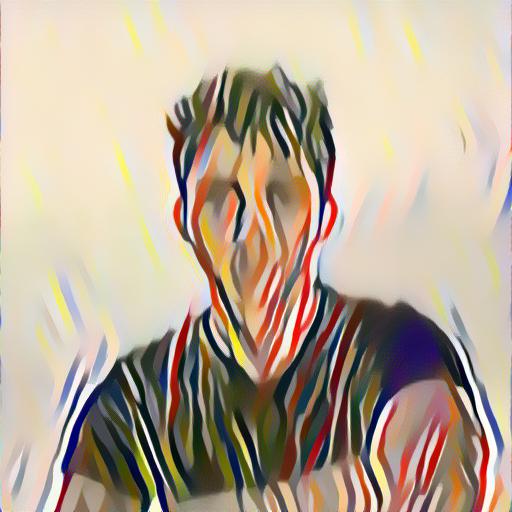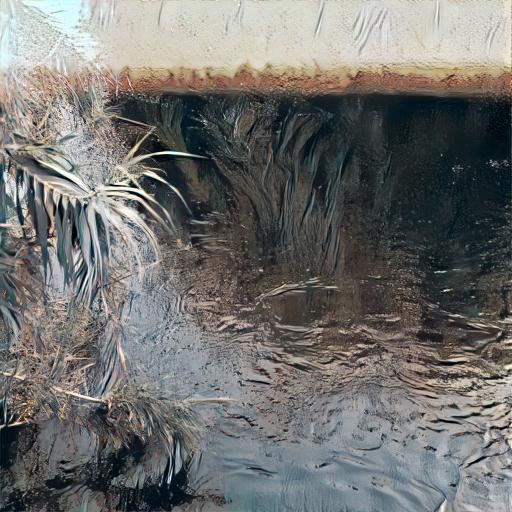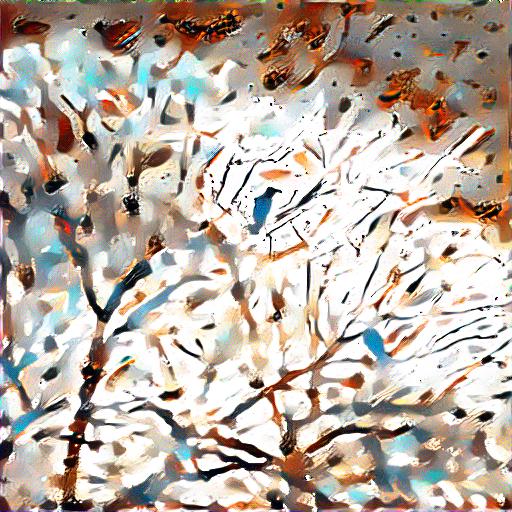A.I. Painting: A Visual Essay
Digital Design, Aritifical Intelligence
Year ︎︎︎ 2021
By using a transfer-learning algorithm, I created an A.I. that generates paintings and later prints them on canvas. The process of generating new work is done by feeding different input and output images, as well as exploring combinations of several different art styles.
I wanted to ask the question of whether A.I. is possible of showing unconventional creativity, or whether it is just programmed to behave a certain aspect of its computational possibilities.
I wanted to ask the question of whether A.I. is possible of showing unconventional creativity, or whether it is just programmed to behave a certain aspect of its computational possibilities.

With the revolutionary advances in machine learning and other deep learning algorithms such as Generative Adversarial Network (GAN), artists can create works they have never imagined before.
For artists like Mario Klingemann who teaches A.I. art in Sónar+D, the most interesting part of working with Neural Network-based algorithm is the unknown surprises. Even though most of the work nowadays is transforming input data into another visualizing example of imagery, the same theory and workflow can also be applied to sound, text, and other formats of data, simply put, A.I. has fundamentally changed the way people define “creativity” and creation and vice versa.








However, according to a review by MIT professor Sean Dorrance Kelly, he believes that “creativity is different from novelty” which means “new and edgy”. For instance, a music learner may hit notes randomly without any meaningful sense which is aside from traditional musical training, in other words, is novel but not creative. Creativity has long been counted as an inspiration that is associated with the historical boundary, some works that were deceived during its period may be considered creative later in the years.
Computer scientist Alan Turing on the other hand thinks differently as he defines creativity as “surprise”. His idea of the random generative machine is somehow similar to artists like Mario Klingemann who uses a machine to think “outside of the box” as they explore the possibility of randomness that theoretically exists even so is normally deceived by human brains since it is unorthodox or arbitrary. This kind of insights on randomness as creativity or large combinations as bits of intelligence is not surprising as artists like Gerhard Richter, Ellsworth Kelly, or others in Dadaism explore this “creativity as chances” or by their words “chance became our trademark. We followed it like a compass”.
Computer scientist Alan Turing on the other hand thinks differently as he defines creativity as “surprise”. His idea of the random generative machine is somehow similar to artists like Mario Klingemann who uses a machine to think “outside of the box” as they explore the possibility of randomness that theoretically exists even so is normally deceived by human brains since it is unorthodox or arbitrary. This kind of insights on randomness as creativity or large combinations as bits of intelligence is not surprising as artists like Gerhard Richter, Ellsworth Kelly, or others in Dadaism explore this “creativity as chances” or by their words “chance became our trademark. We followed it like a compass”.










The objection of rationalism is itself a new artistic norm that will then go down into history, while artists in the past use splattering, dripping, pouring, pulling, body painting, found objects or their subconsciousness which is highly influenced by psychologists like Sigmund Freud or Carl Jung to create unconventional masterpieces, artists now use machine or more specifically, “generators” to help to create works that are out of boundary and not restrained by any rules as they are combinations and calculations of random functions.
Additionally, we could also look at the question from a different perspective away from defining or redefining the word “creativity”, which is “whether machine knows the fact that it is creating something or not?”.
Additionally, we could also look at the question from a different perspective away from defining or redefining the word “creativity”, which is “whether machine knows the fact that it is creating something or not?”.




Since we would always associate artists with their works as we impose them with terms like creative genius and belives their creativity comes from something deep inside their brains even though it’s highly abstract and uncontrollable.
Yet if we first accept the idea that machine is objectively able to create unconventional works, we might ask ourselves whether machine knows the fact that it is an unconventional work and thus is a choice of decision making. It is biased and comes from something deep inside their structure (which we often associate the word “neuron” with it), and eventually is a self-aware creativity.
This is different from referring to the fact that machine is intelligent, but the fact that it creates things based on true pieces of knowledge. Modernism expressivist thinks creation is something from you, and the origin of those things is connected to your work of art. English philosopher Robin George Collingwood along with western arts’ romantic tradition echoes the idea as he defines creation as self-expression, expressing things or emotions through understanding. They also invented the word genius that ties to our previous discussion.
Yet if we first accept the idea that machine is objectively able to create unconventional works, we might ask ourselves whether machine knows the fact that it is an unconventional work and thus is a choice of decision making. It is biased and comes from something deep inside their structure (which we often associate the word “neuron” with it), and eventually is a self-aware creativity.
This is different from referring to the fact that machine is intelligent, but the fact that it creates things based on true pieces of knowledge. Modernism expressivist thinks creation is something from you, and the origin of those things is connected to your work of art. English philosopher Robin George Collingwood along with western arts’ romantic tradition echoes the idea as he defines creation as self-expression, expressing things or emotions through understanding. They also invented the word genius that ties to our previous discussion.








From that on, we can start deconstructing the problem and eventually conclude whether a machine is creative or not. First, philosophy has long been arguing about whether a machine is capable of knowing something by itself. Knowing something is different from “understanding” something as well as having consciousness is different from simply computing. A famous thought experiment proposed by philosopher John Searle in his paper, "Minds, Brains, and Programs", also known as “Chinese room argument” gives the view that digital computing machine is not truly understanding what it is doing even though it behaves intelligently doing inputs and outputs. The program itself is not necessarily creating consciousness, and is otherwise a just a “dog level processing”.
Second, machines cannot have an origin. As Ada, the first female programmer that invented Babbage’s analytical engine quoted the fact that the machine has “no pretensions whatever to originate anything”. The belief that they cannot be original is against every definition of creativity and thus not authentic nor creative.
Second, machines cannot have an origin. As Ada, the first female programmer that invented Babbage’s analytical engine quoted the fact that the machine has “no pretensions whatever to originate anything”. The belief that they cannot be original is against every definition of creativity and thus not authentic nor creative.




Machines has no original intention and is constrained by the input data or designed model given by its creator, it is not producing anything new but simply something that is already
programmed with billions or trillions combinations. The purpose of randomness is however, not creating original work, but to stop it from generating the same work everytime it outputs. It is simply a volume of infromation but not an original processing as it is solely following a script. In conclusion, machine can never be original.
We have neglected some pre-modern view of creativity as mimesis that often be called an imitative art perspective, but we have concluded that machine is not capable of creativity as a weak Artificial Intelligence being programmed and fed by human engineers.
With the fact of it lacking consciousness and origin, we can in closing lead to a mere conclusion that artifical intelligence now is not creative and cannot be creative.
programmed with billions or trillions combinations. The purpose of randomness is however, not creating original work, but to stop it from generating the same work everytime it outputs. It is simply a volume of infromation but not an original processing as it is solely following a script. In conclusion, machine can never be original.
We have neglected some pre-modern view of creativity as mimesis that often be called an imitative art perspective, but we have concluded that machine is not capable of creativity as a weak Artificial Intelligence being programmed and fed by human engineers.
With the fact of it lacking consciousness and origin, we can in closing lead to a mere conclusion that artifical intelligence now is not creative and cannot be creative.
︎